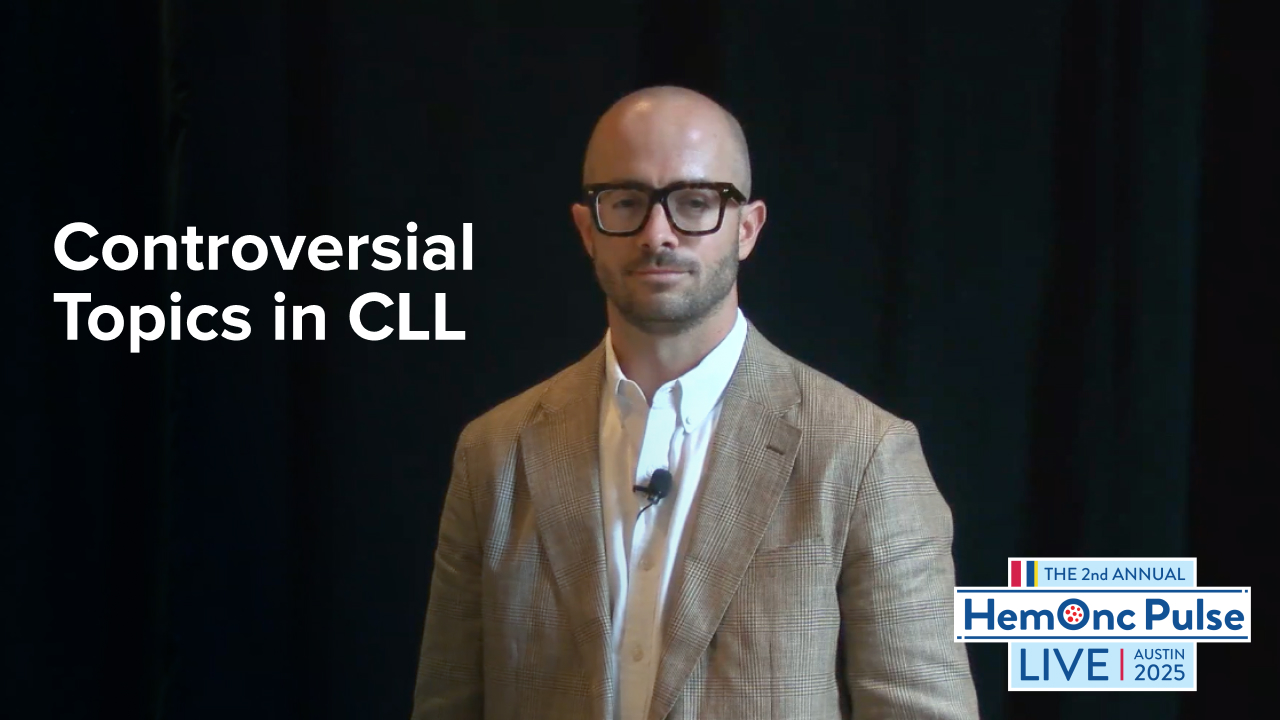With a growing number of treatment options, clinicians need guidance on the best third-line options for patients with CML
The discovery of tyrosine kinase inhibitors (TKIs) that target the BCR-ABL1 fusion protein transformed the treatment of chronic myeloid leukemia (CML) into a chronic disease that could be managed with an oral therapy. These TKIs are highly effective in newly diagnosed, chronic-phase disease, and patients can experience overall survival (OS) near that of aged-matched controls.
Despite that, more than 50% of patients with CML in chronic phase treated with frontline, first-generation TKI imatinib will eventually develop resistance or intolerance to the drug. Similarly, about 30% to 40% of patients treated with a second-generation TKI in the frontline setting will need to change therapy within five years.
“Despite the fact that we think treatment for patients with CML is so good, the reality is that a large percentage of patients end up having to change therapy,” said Jorge E. Cortes, MD, Director of the Georgia Cancer Center at Augusta University. “Selection of a third-line treatment is not an uncommon clinical scenario.”
Clear guidelines from the National Comprehensive Cancer Network (NCCN) and others exist for selection of first- and second-line therapies, but little research has addressed the topic of third-line options.
“Now, because we are having newer options and more options, it has become more of a conversation,” Dr. Cortes said. “There is a question of which to use and when.”
What is Third Line?
Part of the problem in defining best third-line options is that there is no one path that fits all patients.
“What do you define as third line?” asked Jeffrey H. Lipton, MD, PhD, a Clinician Investigator at Princess Margaret Cancer Centre in Toronto, Ontario, Canada. “Are you switching therapy because a patient didn’t like how they felt on one drug? Did they fail treatment? In the United States, there is a greater propensity to jump between drugs more quickly. In Canada, it is a bit more difficult to get approval.”
To begin to choose a third-line therapy, one has to go back and examine first-line therapy, he said. When considering a first-line therapy, Dr. Lipton said he may look at whether the patient presented in chronic or accelerated phase, choose a drug based on patient preference, or choose a drug based on what he is more comfortable prescribing and managing.
In the United States, there are currently four approved first-line options for CML: imatinib and three second-generation TKIs, bosutinib, dasatinib, and nilotinib. In clinical trials, there have been no significant differences in survival outcomes in patients who start therapy on imatinib compared with available second-generation TKIs.1
“In Canada, choice of first-line therapy often comes down to one that will be reimbursed,” Dr. Lipton said.
Next, Dr. Lipton considers a patient’s second-line therapy. Approved second-line therapies include dasatinib, nilotinib, bosutinib, and third-generation TKI ponatinib. Did the patient become intolerant to the first-line treatment? Did they have significant non-hematologic toxicities? It is also possible that the patient did not respond or achieved a response and lost it.
For a patient who lost response, Dr. Lipton will test for resistance mutations. Resistance mutations in the kinase domain of BCR-ABL1 explain many but not all TKI resistance. Patients with T315I mutations will derive no benefit from treatment with dasatinib, nilotinib, or bosutinib.
Selection of third-line treatment is based on this cascade of facts and considerations, he said. “Each cascade will be different based on the reason the patient moved to second or third line,” Dr. Lipton said.
In fact, in a 2016 review article, Dr. Cortes and Hagop Kantarjian, MD, of the University of Texas MD Anderson Cancer Center, mapped out at least 48 unique sequences of possible treatment approaches in CML, and these did not include stem cell transplant, combination therapy, or investigational options.2
What Are the Options?
“Once you get to the third line, I look at two things: patient comorbidities and mutations,” said Ehab L. Atallah, MD, Professor of Medicine and Section Head of Hematological Malignancies in the Medical College of Wisconsin Division of Hematology and Oncology.
Although all of the available TKIs are generally well tolerated, each has its own unique side effect profile. For example, in a patient with lung issues, nilotinib and bosutinib may be the preferred choice, as dasatinib is associated with a higher rate of pleural effusion that requires close monitoring for patients at risk.
In patients with a history of heart problems such as arrhythmias or heart disease, dasatinib or bosutinib may be better options. The label for nilotinib contains a black box warning about risk of QT interval prolongation and sudden cardiac death. Nilotinib is also associated with an increased risk of peripheral arterial occlusive disease.
A patient with a history of inflammatory bowel disease or Crohn’s disease may prefer not to use bosutinib, which has been linked with high rates of diarrhea.
Ponatinib contains a black box warning regarding vascular occlusion, heart failure, and hepatoxicity. Patients with diabetes may be more difficult to manage when using ponatinib, Dr. Cortes said.
“The good thing about the number of options we have is that you can select treatment based on these elements and try to minimize risk as much as you can,” Dr. Cortes said.
However, Dr. Atallah noted that avoidance of risk factors may be prioritized a bit less in this later line of treatment than in selection of frontline treatment.
“In the third line you are getting into an area where you are balancing risk and benefits,” Dr. Atallah said. “If you have someone with a heart problem, but you think ponatinib or nilotinib is the best option, you have to go with that option with the understanding of the cardiovascular risk.”
Dr. Lipton also noted that there is no specific side effect unique to any one of these drugs, just some that occur more commonly with one compared to another.
Outside of consideration of these side effect profiles, the majority of patients moving into the third line have been treated with either a first-generation TKI followed by a second-generation TKI or two prior second-generation TKIs. There have been quite a few trials and case series looking at the third-line use of a second-generation TKI after prior failure of imatinib and another second-generation TKI, but most have shown poor long-term outcomes for patients.
For example, one retrospective study assessed 90 patients with CML treated with first-line imatinib who did not have access to new or investigational therapies. The eight-year OS was significantly lower for patients who went through three or more lines of therapy compared with those who maintained imatinib in the first line.3
Additionally, sequential use of TKIs can result in emergence of new mutations, further limiting treatment options. If the patient has not already been tested for a resistance mutation, testing should be done prior to selection of third-line therapy.
The previously mentioned BCR-ABL1 T315I mutation means that disease will be resistant to all ATP-binding TKIs except ponatinib.
The PACE trial administered ponatinib to patients resistant or intolerant to dasatinib or nilotinib or those with T315I mutations. Final results of the study showed a median duration of treatment of 32.1 months, with 60% achieving a major cytogenetic response (MCyR) at any time. More than half of patients (56%) had MCyR by 12 months.4
Omacetaxine, a semisynthetic formulation of homoharringtonine, is another drug approved for patients with chronic-phase CML that is resistant or intolerant to two or more TKIs, including patients with a T315I mutation. The approval was based on CML-300, which pooled data from two phase II studies. Final results of CML-300 showed that 18% of patients achieved MCyR with a median duration of 12.5 months. In patients in accelerated phase, 14% achieved or maintained major hematologic response.5
However, the modest activity of omacetaxine has limited its use to patients who cannot tolerate TKIs and are not eligible for transplant.
According to Dr. Cortes, the majority of patients will have no detectable mutations or will have a mutation but one where there is no predicted difference in efficacy of one drug compared with another.
Newest Option
In October 2021, the U.S. Food and Drug Administration (FDA) approved the first-in-class allosteric myristoyl inhibitor asciminib as a third-line option for patients with chronic-phase CML with resistance or intolerance to two prior lines of TKI therapy. The European Commission approved asciminib in late August 2022.6
“All approved TKIs bind to the ATP-binding pocket, but asciminib is the first-in-class that binds to the myristoyl pocket,” Dr. Atallah said. “Because it binds in a different spot, it can work where other drugs don’t, in cases where the BCR-ABL mutation prevents the other TKIs from binding.”
The approval was based on the results of two clinical trials. The ASCEMBL trial randomized 233 patients with Philadelphia chromosome (Ph)-positive CML in chronic phase to asciminib 40 mg twice daily or bosutinib 500 mg once daily. Major molecular response (MMR) at 24 weeks was 25.5% in the asciminib arm compared with 13.2% in the bosutinib arm. With a median follow-up of 20 months, the median duration of MMR has not been reached.7
The open-label CABL001X2101 trial assessed asciminib in patients with Ph-positive CML in chronic phase with the T315I mutation. MMR at 24 weeks occurred in 42% of patients. At 96 weeks, MMR was achieved by 49%.6
Based on the FDA approval, an NCCN advisory panel supported the addition of asciminib as a treatment option for chronic-phase CML with the T315I mutation and/or those with resistance or intolerance to at least two prior TKIs.8
Because asciminib binds to a different spot, there is also the possibility that the drug could be used in combination with other TKIs and that this combination could lead to better outcomes, Dr. Atallah said.
Dr. Atallah is currently involved in two clinical trials from the H. Jean Khoury Cure CML Consortium looking at combination treatment with asciminib. One phase II study will use frontline asciminib in patients with newly diagnosed CML and add nilotinib in those who have not achieved a deep response after 24 months of single-agent treatment.9 A second phase II study is looking at the use of imatinib plus asciminib in patients who relapsed after a prior attempt at TKI discontinuation.10
Role of Transplant
The activity of TKIs in the treatment of CML has transformed patient management and outcomes. As a result, allogeneic hematopoietic stem cell transplantation (HSCT), once a mainstay of treatment, is no longer the only option to achieve long-term survival.
“When I started out, half of the transplants I performed were for CML,” Dr. Lipton said. “Back then, I performed maybe 40 a year. Now I do close to 200 a year but only one or two for CML.”
Dr. Atallah estimated that only 5% to 10% of patients with CML end up getting a transplant. He noted though that it should be considered once a patient gets to the third line.
“If they are fit and not responding well, you should consider transplant,” Dr. Atallah said. “Any patient who has progressed to accelerated phase or blast crisis should get a transplant. That is the only chance at a long-term cure.”
Dr. Lipton agreed, “These drugs are good at shutting down the CML clone, but if the clone is producing normal bloods cells then changing drugs won’t help. These individuals may have to go onto transplant.”
In this new era of TKIs, research is ongoing to try to determine how best to incorporate transplant into the treatment of CML.
A small study from a Swedish CML registry showed that about half of patients received allogeneic transplant in first chronic phase, with TKI resistance listed as the most common reason for transplant.11 For patients diagnosed with CML in chronic phase who were younger than 65 years at diagnosis, the cumulative probability of undergoing HSCT within five years was about 10%. The five-year survival for those transplanted in first chronic phase was 96.2% compared with 36.9% for those transplanted in accelerated phase or blast crisis.
Data from a Japanese study also support the use of allogeneic HSCT in young patients with CML in chronic phase. An analysis of pre-transplant use of TKIs in 237 patients showed that non-relapse mortality was higher in patients treated with three TKIs than in patients treated with one or two TKIs.12
Most recently, a non-interventional study from the Chronic Malignancy Working Party of the European Society for Blood and Marrow Transplantation demonstrated the feasibility of transplant in patients previously treated with a second-generation TKI, with no differences in post-transplant complications for patients treated with dasatinib, nilotinib, or sequential treatment of dasatinib and nilotinib with or without bosutinib or ponatinib.13
“Certainly, in the third line you have to at least consider transplant and have that conversation with your patient,” Dr. Cortes said. “Even if you don’t do the transplant, it has to be discussed when moving into third-line therapy.”
New Targets
There is also a large body of research into novel therapeutics with non-BCR-ABL1 targets, Dr. Atallah said.
As with many other cancer types, immune checkpoint inhibitors with PD-(L)1 inhibitors are being explored in CML, although most data are still in phase I. There is also interest in JAK/STAT inhibitors, he said. Preclinical research has shown that targeting the JAK/STAT pathway could increase TKI-induced apoptosis. RAS inhibition, histone deacetylase inhibition, and hypomethylating agents, among others, are also being explored in combination with TKIs.
In addition, so-called fourth-generation TKIs are also being studied. PF-114 is a fourth-generation TKI that is active against wild-type and mutated BCR-ABL1 isoforms. PF-114 has a structure similar to ponatinib but was designed not to inhibit the VEGF receptor in order to reduce possible cardiovascular effects.14
“The goal of third-line therapy is always to maintain a certain level of response with a minimum amount of side effects, while still aiming for a deeper molecular response,” Dr. Cortes said. “Considering all of those things plays a role in what we ultimately will select for the patient.”
Leah Lawrence is a freelance health writer and editor based in Delaware.
References
- Deininger MW, Shah NP, Altman JK, et al. Chronic Myeloid Leukemia, Version 2.2021, NCCN Clinical Practice Guidelines in Oncology. J Natl Compr Canc Netw. 2020;18(10):1385-1415.
- Cortes J, Kantarjian H. Chronic myeloid leukemia: sequencing of TKI therapies. Hematology Am Soc Hematol Educ Program. 2016(1):164-169.
- Bosi GR, Fogliatto LM, Costa TEV, et al. What happens to intolerant, relapsed or refractory chronic myeloid leukemia patients without access to clinical trials? Hematol Transfus Cell Ther. 2019;41(3):222-228.
- Cortes JE, Kim DW, Pinilla-Ibarz J, et al. Ponatinib efficacy and safety in Philadelphia chromosome-positive leukemia: final 5-year results of the phase 2 PACE trial. Blood. 2018;132:393-404.
- Cortes J, Kantarjian H, Rea D, et al. Final analysis of efficacy and safety of omacetaxine mepesuccinate in patients with chronic phase (CP) or accelerated phase (AP) chronic myeloid leukemia (CML): 24-month minimum follow-up results. Cancer. 2015;121(10):1637-1644.
- U.S. Food and Drug Administration. FDA approves asciminib for Philadelphia chromosome-positive chronic myeloid leukemia. October 29, 2021. Accessed September 14, 2022. www.fda.gov/drugs/resources-information-approved-drugs/fda-approves-asciminib-philadelphia-chromosome-
positive-chronic-myeloid-leukemia - Rea D, Mauro MJ, Boquimpani C, et al. A phase 3, open-label, randomized study of asciminib, a STAMP inhibitor, vs bosutinib in CML after 2 or more prior TKIs. Blood. 2021;138(21):2031-2041.
- NCCN Chronic Myeloid Leukemia v.2.2022 – Meeting. November 3, 2021. Accessed September 14, 2022. www.nccn.org/guidelines/guidelines-process/transparency-process-and-recommendations//GetFileFromFileManager?fileManagerId=12995
- ClinicalTrials.gov. Asciminib as Initial Therapy for Patients with Chronic Myeloid Leukemia in Chronic Phase. ClinicalTrials.gov Identifier: NCT05143840.
- ClinicalTrials.gov. Protocol Number: HJKC3-0003. Treatment Free Remission After Combination Therapy with Asciminib (ABL001) Plus Imatinib in Chronic Phase Chronic Myeloid Leukemia (CP-CML) Patients Who Relapsed After a Prior Attempt at TKI Discontinuation. ClinicalTrials.gov Identifier: NCT04838041.
- Lubking A, Dreimane A, Sandin F, et al. Allogeneic stem cell transplantation for chronic myeloid leukemia in the TKI era: population-based data from the Swedish CML registry. Bone Marrow Transplant. 2019;54(11):1764-1774.
- Kondo T, Nagamura-Inoue T, Tojo A, et al. Clinical impact of pretransplant use of multiple tyrosine kinase inhibitors on the outcome of allogeneic hematopoietic stem cell transplantation for chronic myelogenous leukemia. Am J Hematol. 2017;92(9):902-908.
- Masouridi-Levrat S, Olavarria E, Iacobelli S, et al. Outcomes and toxicity of allogeneic hematopoietic cell transplantation in chronic myeloid leukemia patients previously treated with second-generation tyrosine kinase inhibitors: a prospective non-interventional study from the Chronic Malignancy Working Party of the EBMT. Bone Marrow Transplant. 2002;57(1):23-30.
- Andretta E, Costa C, Longobardi C, et al. Potential approaches versus approved or developing chronic myeloid leukemia therapy. Front Oncol. 2021;11:801779.






 © 2025 Mashup Media, LLC, a Formedics Property. All Rights Reserved.
© 2025 Mashup Media, LLC, a Formedics Property. All Rights Reserved.